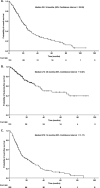Natural history of chronic myelomonocytic leukemia treated with hypomethylating agents
- PMID: 28370097
- PMCID: PMC5553721
- DOI: 10.1002/ajh.24735
Natural history of chronic myelomonocytic leukemia treated with hypomethylating agents
Abstract
Hypomethylating agents (HMA) are the most commonly used therapeutic intervention in chronic myelomonocytic leukemia (CMML). Due to the lack of CMML-specific clinical trials, the impact of these agents in the natural history of CMML is not fully understood. We present the largest retrospective series of CMML (n = 151) treated with HMA. Mean age at diagnosis was 69 years (range 50-88). According to the CMML-specific prognostic scoring system (CPSS): 17 (15%) were low-risk, 45 (39%) intermediate-1 risk, 42 (36%) intermediate-2, and 12 (10%) high-risk. 35 (23%) patients received single agent azacitidine, 73 (48%) single agent decitabine, and 43 (29%) combinations. With a median follow-up of 17 months, overall response rate (ORR) was 75%, with 41% achieving complete response (CR). Median overall survival (OS) was 24 months (95%CI: 20-28) and event-free survival 14 months (95%CI: 11-17). By multivariate analysis, age < 70 years, higher levels of hemoglobin, absence of blast in peripheral blood and lower CPSS cytogenetic risk predicted for better OS. CR was significantly higher in those patients treated with decitabine (58.3%) when compared with azacitidine (20.6%) (P < .001). 13 patients (9%) received allo-SCT after a median of 4 cycles of HMA. 66 patients (50%) had HMA failure: 26 primary (34%) and 50 secondary (66%), including 35 (46%) that transformed to AML. Outcomes after HMA failure were poor with OS of 7 months (95%CI: 3-12). In conclusion, HMA are effective in CMML but new agents and combinations are needed. This data could be a benchmark for further drug development in CMML.
© 2017 Wiley Periodicals, Inc.
Figures


References
-
- Jaffe ES. Pathology and genetics of tumours of haematopoietic and lymphoid tissues. Lyon: IARC Press; 2001.
-
- Arber DA, Orazi A, Hasserjian R, et al. The 2016 revision to the World Health Organization classification of myeloid neoplasms and acute leukemia. Blood. 2016;127:2391–2405. - PubMed
-
- Vardiman JW, Thiele J, Arber DA, et al. The 2008 revision of the World Health Organization (WHO) classification of myeloid neoplasms and acute leukemia: rationale and important changes. Blood. 2009;114:937–951. - PubMed
-
- Rollison DE, Howlader N, Smith MT, et al. Epidemiology of myelodysplastic syndromes and chronic myeloproliferative disorders in the United States, 2001–2004, using data from the NAACCR and SEER programs. Blood. 2008;112:45–52. - PubMed
MeSH terms
Substances
Grants and funding
LinkOut - more resources
Full Text Sources
Other Literature Sources
Research Materials
